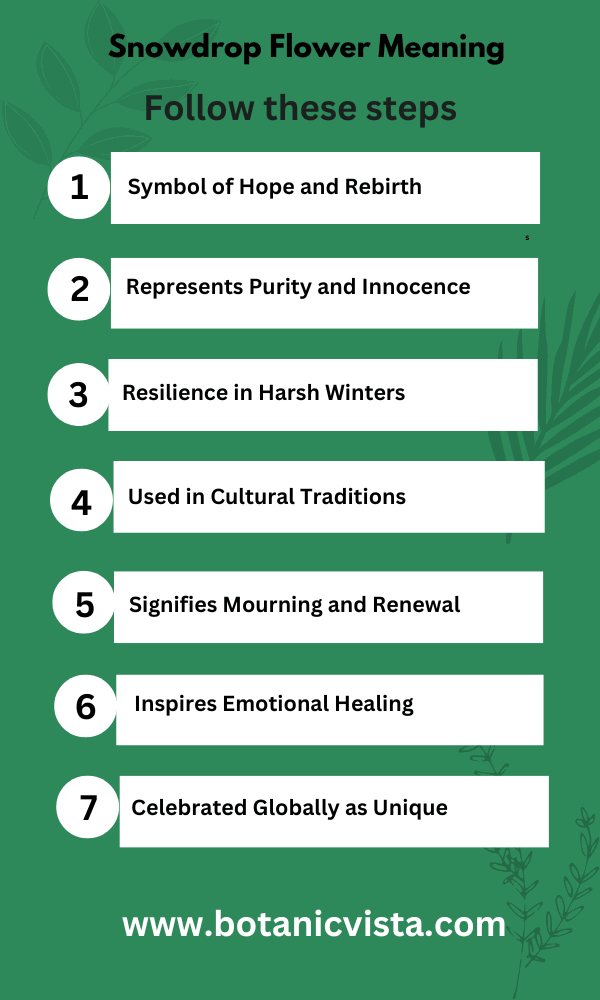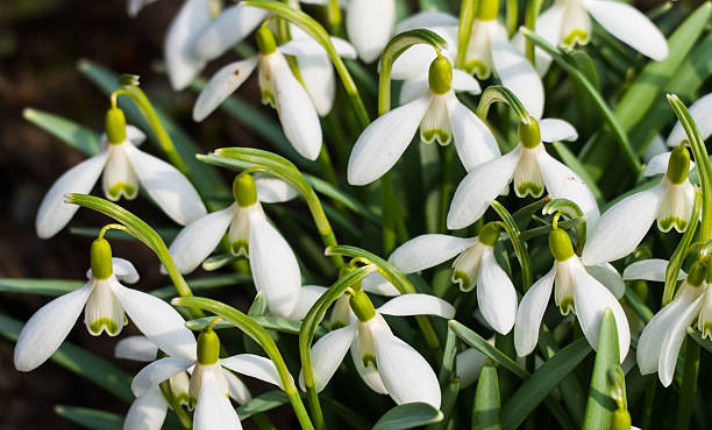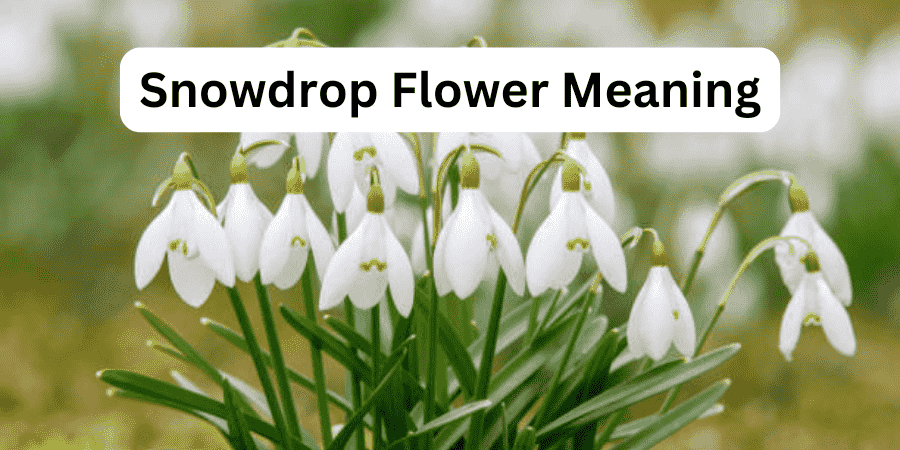Last Updated on October 20, 2024 by Jocelyn
The snowdrop flower is one of the first to bloom in spring, sometimes as early as January. With over 20 species in the Galanthus genus, these flowers are native to Europe and Asia.
Belonging to the Amaryllidaceae family, snowdrops have bell-shaped blooms with green-tipped petals on thin stems. Their narrow, strap-like leaves typically reach 3-6 inches in height. These flowers symbolize hope and renewal as they break through the snow, marking the beginning of spring.
Snowdrops are popular garden plants that spread easily through seeds and bulb offsets. They are often found in woodland areas and are cherished for their simple elegance and endurance as they emerge from the cold ground each year. Their presence signals that warmer days are on the way, making them a welcome sight in any garden.

Table of Contents
ToggleEtymology and Origins of the Snowdrop Flower
The snowdrop flower, Galanthus, comes from Greek words. “Gala” means “milk,” and “anthos” means “flower.” The name was classified by Carl Linnaeus in 1753. It’s called “snowdrop” because it blooms in early spring when snow is still on the ground, resembling white drops of snow.
The scientific name, Galanthus nivalis, means “milk flower” in Latin. The delicate white flower is known as “snaowdropa” in ancient languages. Its common name comes from “snow” and “drops,” reflecting how it pushes through the snow to bloom.
Symbolism of Snowdrops
These delicate blooms symbolize hope, rebirth, and purity as they emerge in late winter, marking new beginnings and resilience. Their presence brings joy and profound emotions, bridging the sorrow of winter with the promise of spring.
1. Rebirth and Hope
Snowdrops symbolize rebirth and hope, appearing in late winter or early spring to signal new beginnings. Their white petals reflect purity and innocence, bringing a sense of joy after the sorrow of winter.
2. Purity and Innocence
The snowdrop’s purity is often linked with Christianity, especially during Candlemas, marking the end of winter and the start of spring. In pagan traditions like Imbolc, these blooms symbolize renewal and fragile beauty.
3. Resilience and Perseverance
Snowdrops show resilience and perseverance as they push through the snow. Their tender appearance hides their strength, making them a powerful symbol of overcoming challenges, often used in literature and art to represent profound emotions.
4. Cultural and Religious Traditions
In places like Pennsylvania, and other regions, snowdrops are part of cultural and religious traditions, celebrated especially during January and March. They hold a special place in history and continue to influence human emotions.
5. Mourning and Celebration
Snowdrops are connected to both mourning and celebration. Their symbolic association with sorrow and sympathy makes them popular in times of loss, yet their visual appeal and tenderness bring joy during new beginnings.
6. Impact on Human Emotions and Experiences
The symbolism of snowdrops is deeply rooted in human emotions. Their delicate appearance in winter evokes profound feelings, from sorrow to hope, reminding us of the fragile balance between life and death and the future possibilities they represent.
Historical and Cultural Significance of Snowdrops
Snowdrops are tiny white flowers with a rich history, admired for their beauty and significance across many cultures. Ancient civilizations like the Greeks and Romans used them for medicine, while in medieval times, they were seen as symbols of protection. Today, snowdrops continue to be valued in gardens and hold a special place in legends and traditions.

The History of Snowdrops
Snowdrops have a rich history, originating in Europe and spreading across the world. Ancient Greeks and Romans first admired these delicate flowers, using them for medicinal purposes. Over time, they became a symbol of hope and purity in medieval churchyards.
By the 19th century, they were widely naturalized in North America and became popular in gardens and parks.
Snowdrops in Global Cultures
In various cultures, it holds special significance. For example, in Moldovan legend, Lady Spring defeated the Winter Witch, marking the arrival of spring with the bloom of snowdrops. Similarly, Urdu and Korean traditions also celebrate the arrival of spring with the sight of these flowers, linking them to themes of rebirth and renewal.
Galanthomania: The Snowdrop Obsession
“Galanthomania” refers to the historical obsession with snowdrops, especially in the Victorian era. This fascination led to the creation of numerous cultivars and the celebration of snowdrop festivals in places like Scotland and Pennsylvania. These festivals continue to highlight the cultural significance of snowdrops, drawing enthusiasts from around the world.
The Best Places to See Snowdrops
Snowdrops bloom in many beautiful places. You can see them in gardens, parks, and woodlands. Each spot has its own special charm with carpets of white flowers.
| Category | Notable Locations | Description |
| Botanical Gardens | Royal Botanic Garden Edinburgh, Kew Gardens | Famous for well-maintained carpets of snowdrops, with propagation techniques. |
| Woodlands and Parks | Ashridge Estate, Highgrove House | Natural settings with drifts of snowdrops under deciduous trees. |
| Snowdrop Festivals | Snowdrop Festival in Gloucestershire, Nymans Garden | Annual events with guided walks and workshops to enjoy the blooms. |
Cultivating and Caring for Snowdrops
Snowdrops are graceful, early bloomers that add a fresh touch of spring to any garden. These delicate flowers flourish in cool climates and require minimal care. Their elegant simplicity makes them a cherished sight after winter.
- Ideal Growing Conditions for Snowdrops
These delicate flowers do well in part shade or full sun. They prefer rich humus soil that has good drainage. They are suitable for various climates, from southern gardens to the far north. A cold period with temperatures as low as minus 30° is needed for them to bloom.
- Planting and Maintenance Tips
Plant the bulbs in the fall, about 2-3″ deep in well-prepared soils. The bulbs require stratification to grow successfully. Keep the soil slightly moist but not overly wet. These flowers are simple to care for with minimal effort.
- When to Expect Your Snowdrops to Bloom
Expect them to bloom after a cold period when temperatures rise above 20°. In warmer areas like southern gardens, blooming might happen earlier. In the far north, blooming can be delayed depending on the weather conditions.
Discover more tips for lush, lasting blooms:
- How Long Do Orchid Blooms Last? Ultimate Guide
- Hoya Plant Blooming – Quick Tips to Boost Blooms
- When Does Lavender Bloom? A Complete Seasonal Guide
- Planting Tulips in Spring – Tips for Stunning Blooms!
FAQ’s
Q: What Is an Interesting Fact About Snowdrops?
A: Snowdrops, known as Galanthus, have a natural antifreeze in their bulbs that protects them during frosty nights. This allows them to survive freezing stress and recover even when the temperatures rise after cold spells.
Q: Can You Touch Snowdrop Flowers?
A: Snowdrops and certain plants like Alocasia and Red Secret can cause skin irritation if touched, leading to red, itchy spots, or even blisters. Always wear gloves to avoid these reactions.
Q: How Long Do Snowdrop Flowers Last?
A: Snowdrops bloom in late winter or early spring and last about two weeks before they start to fade. Novice gardeners should plant them when the leaves are still green but the blooms have already dropped.
Q: Why Do Snowdrops Face Down?
A: Snowdrops face down to protect their pollen from wintery showers and cold temperatures. This position also helps pollinating insects in cold weather.
Q: Why Are Snowdrops Special?
A: Snowdrops are special because they are the first flowers to appear in early spring. Seen between January and February in the northern hemisphere, they symbolize purity and new beginnings.
Conclusion
Snowdrop flowers are like little messengers of hope. They appear when winter is almost over, signaling brighter days ahead. Their simple beauty reminds us of new beginnings. Seeing them can lift your spirits and bring a sense of peace. It’s nature’s way of showing that even in dark times, a fresh start is near. So, when you spot a snowdrop, remember that good things are on the horizon.

